2008 KIA Rio warning
[x] Cancel search: warningPage 47 of 219
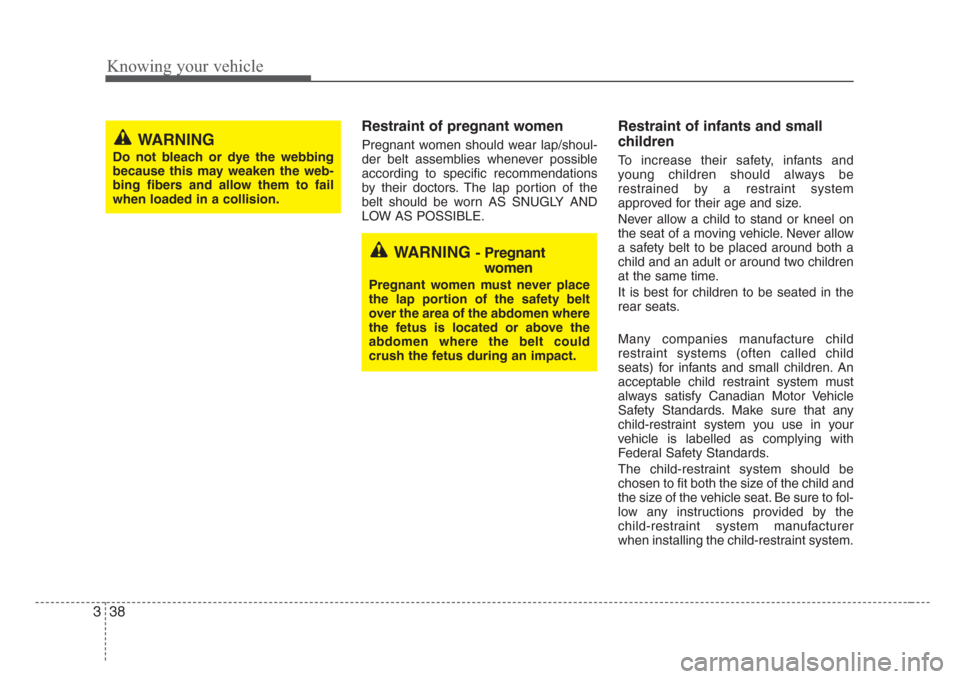
Knowing your vehicle
38 3
Restraint of pregnant women
Pregnant women should wear lap/shoul-
der belt assemblies whenever possible
according to specific recommendations
by their doctors. The lap portion of the
belt should be worn AS SNUGLY AND
LOW AS POSSIBLE.
Restraint of infants and small
children
To increase their safety, infants and
young children should always be
restrained by a restraint system
approved for their age and size.
Never allow a child to stand or kneel on
the seat of a moving vehicle. Never allow
a safety belt to be placed around both a
child and an adult or around two children
at the same time.
It is best for children to be seated in the
rear seats.
Many companies manufacture child
restraint systems (often called child
seats) for infants and small children. An
acceptable child restraint system must
always satisfy Canadian Motor Vehicle
Safety Standards. Make sure that any
child-restraint system you use in your
vehicle is labelled as complying with
Federal Safety Standards.
The child-restraint system should be
chosen to fit both the size of the child and
the size of the vehicle seat. Be sure to fol-
low any instructions provided by the
child-restraint system manufacturer
when installing the child-restraint system.
WARNING - Pregnant
women
Pregnant women must never place
the lap portion of the safety belt
over the area of the abdomen where
the fetus is located or above the
abdomen where the belt could
crush the fetus during an impact.
WARNING
Do not bleach or dye the webbing
because this may weaken the web-
bing fibers and allow them to fail
when loaded in a collision.
Page 48 of 219
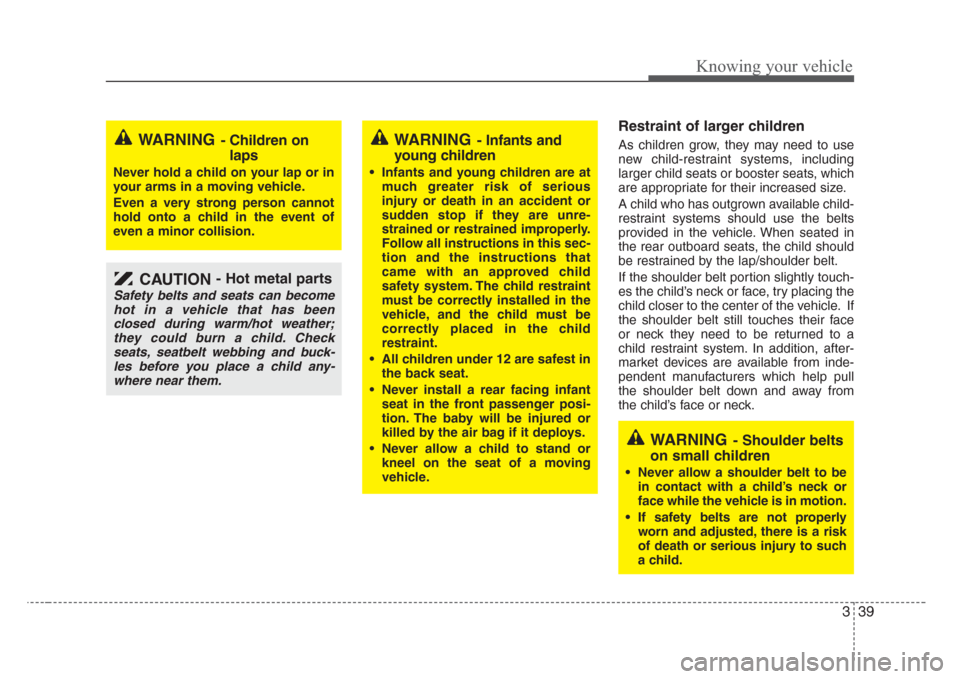
339
Knowing your vehicle
Restraint of larger children
As children grow, they may need to use
new child-restraint systems, including
larger child seats or booster seats, which
are appropriate for their increased size.
A child who has outgrown available child-
restraint systems should use the belts
provided in the vehicle. When seated in
the rear outboard seats, the child should
be restrained by the lap/shoulder belt.
If the shoulder belt portion slightly touch-
es the child’s neck or face, try placing the
child closer to the center of the vehicle. If
the shoulder belt still touches their face
or neck they need to be returned to a
child restraint system. In addition, after-
market devices are available from inde-
pendent manufacturers which help pull
the shoulder belt down and away from
the child’s face or neck.WARNING- Infants and
young children
• Infants and young children are at
much greater risk of serious
injury or death in an accident or
sudden stop if they are unre-
strained or restrained improperly.
Follow all instructions in this sec-
tion and the instructions that
came with an approved child
safety system. The child restraint
must be correctly installed in the
vehicle, and the child must be
correctly placed in the child
restraint.
• All children under 12 are safest in
the back seat.
• Never install a rear facing infant
seat in the front passenger posi-
tion. The baby will be injured or
killed by the air bag if it deploys.
• Never allow a child to stand or
kneel on the seat of a moving
vehicle.
WARNING- Children on
laps
Never hold a child on your lap or in
your arms in a moving vehicle.
Even a very strong person cannot
hold onto a child in the event of
even a minor collision.
CAUTION- Hot metal parts
Safety belts and seats can become
hot in a vehicle that has been
closed during warm/hot weather;
they could burn a child. Check
seats,seatbelt webbing and buck-
les before you place a child any-
where near them.
WARNING- Shoulder belts
on small children
• Never allow a shoulder belt to be
in contact with a child’s neck or
face while the vehicle is in motion.
• If safety belts are not properly
worn and adjusted, there is a risk
of death or serious injury to such
a child.
Page 49 of 219
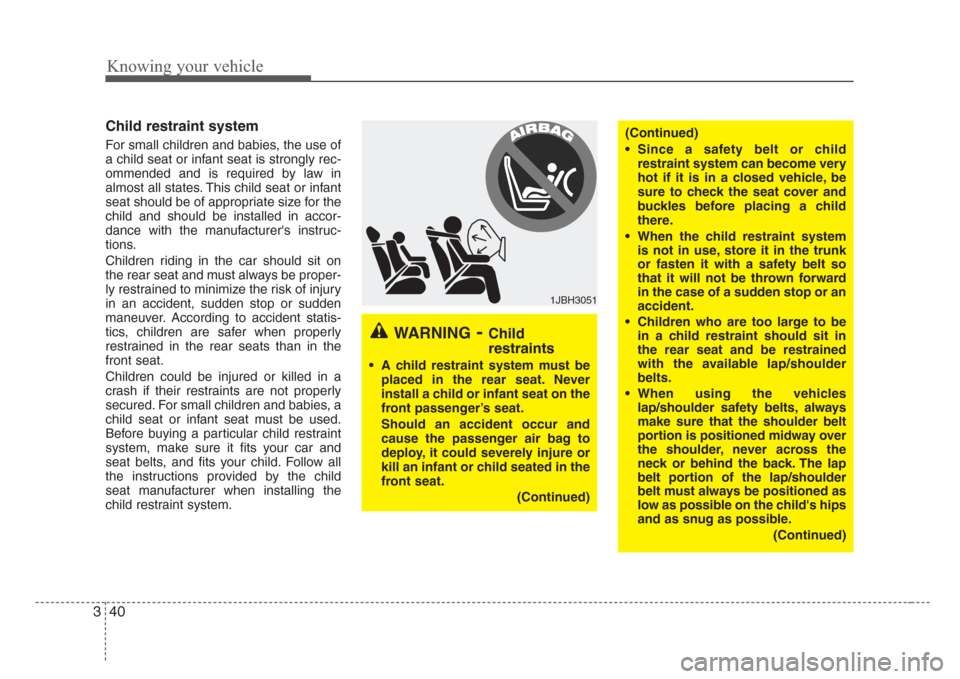
Knowing your vehicle
40 3
Child restraint system
For small children and babies, the use of
a child seat or infant seat is strongly rec-
ommended and is required by law in
almost all states. This child seat or infant
seat should be of appropriate size for the
child and should be installed in accor-
dance with the manufacturer's instruc-
tions.
Children riding in the car should sit on
the rear seat and must always be proper-
ly restrained to minimize the risk of injury
in an accident, sudden stop or sudden
maneuver. According to accident statis-
tics, children are safer when properly
restrained in the rear seats than in the
front seat.
Children could be injured or killed in a
crash if their restraints are not properly
secured. For small children and babies, a
child seat or infant seat must be used.
Before buying a particular child restraint
system, make sure it fits your car and
seat belts, and fits your child. Follow all
the instructions provided by the child
seat manufacturer when installing the
child restraint system.
1JBH3051
WARNING-Child
restraints
• A child restraint system must be
placed in the rear seat. Never
install a child or infant seat on the
front passenger’s seat.
Should an accident occur and
cause the passenger air bag to
deploy, it could severely injure or
kill an infant or child seated in the
front seat.
(Continued)
(Continued)
• Since a safety belt or child
restraint system can become very
hot if it is in a closed vehicle, be
sure to check the seat cover and
buckles before placing a child
there.
• When the child restraint system
is not in use,store it in the trunk
or fasten it with a safety belt so
that it will not be thrown forward
in the case of a sudden stop or an
accident.
• Children who are too large to be
in a child restraint should sit in
the rear seat and be restrained
with the available lap/shoulder
belts.
• When using the vehicles
lap/shoulder safety belts,always
make sure that the shoulder belt
portion is positioned midway over
the shoulder, never across the
neck or behind the back. The lap
belt portion of the lap/s
houlder
belt must always be positioned as
low as possible on the child's hips
and as snug as possible.
(Continued)
Page 50 of 219
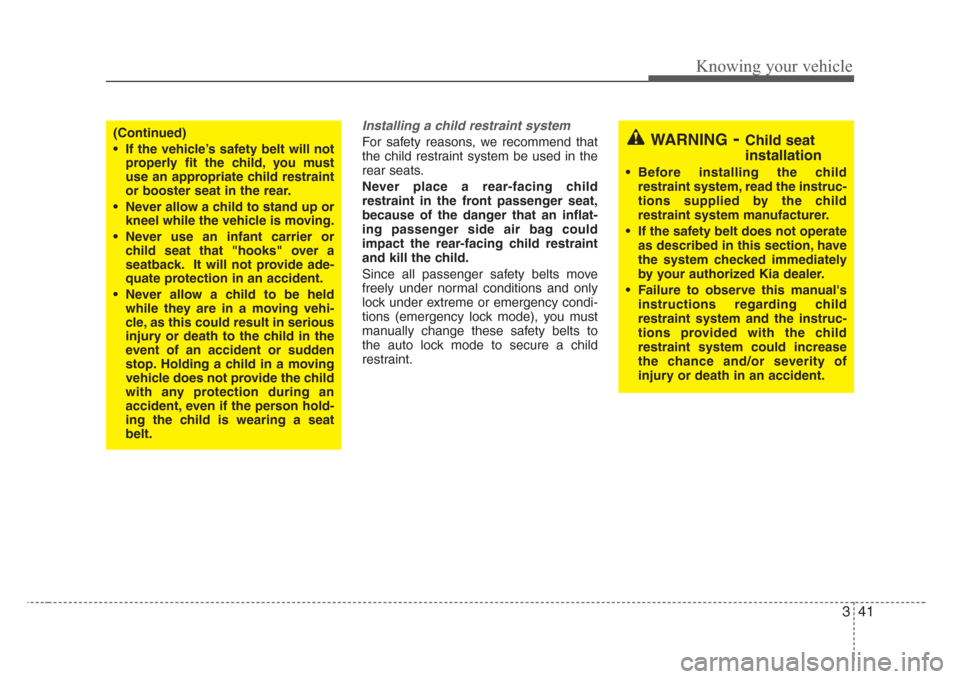
341
Knowing your vehicle
Installing a child restraint system
For safety reasons, we recommend that
the child restraint system be used in the
rear seats.
Never place a rear-facing child
restraint in the front passenger seat,
because of the danger that an inflat-
ing passenger side air bag could
impact the rear-facing child restraint
and kill the child.
Since all passenger safety belts move
freely under normal conditions and only
lock under extreme or emergency condi-
tions (emergency lock mode), you must
manually change these safety belts to
the auto lock mode to secure a child
restraint.(Continued)
• If the vehicle’s safety belt will not
properly fit the child, you must
use an appropriate child restraint
or booster seat in the rear.
• Never allow a child to stand up or
kneel while the vehicle is moving.
• Never use an infant carrier or
child seat that "hooks" over a
seatback. It will not provide ade-
quate protection in an accident.
• Never allow a child to be held
while they are in a moving vehi-
cle, as this could result in serious
injury or death to the child in the
event of an accident or sudden
stop. Holding a child in a moving
vehicle does not provide the child
with any protection during an
accident, even if the person hold-
ing the child is wearing a seat
belt.WARNING-Child seat
installation
• Before installing the child
restraint system, read the instruc-
tions supplied by the child
restraint system manufacturer.
• If the safety belt does not operate
as described in this section, have
the system checked immediately
by your authorized Kia dealer.
• Failure to observe this manual's
instructions regarding child
restraint system and the instruc-
tions provided with the child
restraint system could increase
the chance and/or severity of
injury or death in an accident.
Page 53 of 219
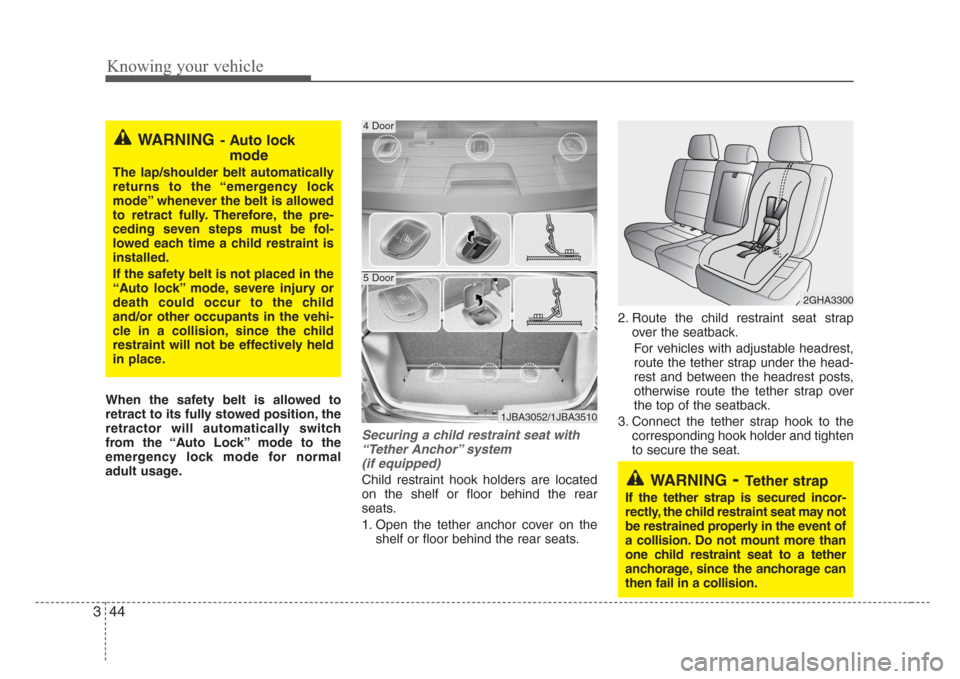
Knowing your vehicle
44 3
When the safety belt is allowed to
retract to its fully stowed position, the
retractor will automatically switch
from the “Auto Lock” mode to the
emergency lock mode for normal
adult usage.
Securing a child restraint seat with
“Tether Anchor”system
(if equipped)
Child restraint hook holders are located
on the shelf or floor behind the rear
seats.
1. Open the tether anchor cover on the
shelf or floor behind the rear seats.2. Route the child restraint seat strap
over the seatback.
For vehicles with adjustable headrest,
route the tether strap under the head-
rest and between the headrest posts,
otherwise route the tether strap over
the top of the seatback.
3. Connect the tether strap hook to the
corresponding hook holder and tighten
to secure the seat.
WARNING- Auto lock
mode
The lap/shoulder belt automatically
returns to the “emergency lock
mode” whenever the belt is allowed
to retract fully. Therefore, the pre-
ceding seven steps must be fol-
lowed each time a child restraint is
installed.
If the safety belt is not placed in the
“Auto lock” mode,severe injury or
death could occur to the child
and/or other occupants in the vehi-
cle in a collision,since the child
restraint will not be effectively held
in place.
1JBA3052/1JBA3510
4 Door
5 Door
2GHA3300
WARNING-Tether strap
If the tether strap is secured incor-
rectly, the child restraint seat may not
be restrained properly in the event of
a collision. Do not mount more than
one child restraint seat to a tether
anchorage,since the anchorage can
then fail in a collision.
Page 54 of 219

345
Knowing your vehicle
Child seat lower anchors
Some child seat manufacturers make
child restraint seats that are labeled as
International Standards Organization
Fixed (ISOFIX) or ISOFIX-compatible
child restraint seats. These seats include
two rigid or webbing mounted attach-
ments that connect to two ISOFIX
anchors at specific seating positions in
your vehicle. This type of child restraint
seat eliminates the need to use seat
belts to attach the child seat for in the
rear seats.There is a child restraint symbol located
on the lower portion of each side of the
rear seatbacks. These symbols indicate
the position of the lower anchors for child
restraints so equipped.
WARNING - Child restraint
check
Check that the child restraint sys-
tem is secured by pushing and
pulling it in different directions.
Incorrectly fitted child restraints
may swing, twist, tip or come away
causing death or injury.
WARNING - Child restraint
anchorage
• Child restraint anchorages are
designed to withstand only those
loads imposed by correctly fitted
child restraints. Under no circum-
stances are they to be used for
adult seat belts or harnesses or
for attaching other items or
equipment to the vehicle.
• The tether strap may not work
properly if attached somewhere
other than the correct tether
anchor.
1JBA31571JBN3053
Page 55 of 219
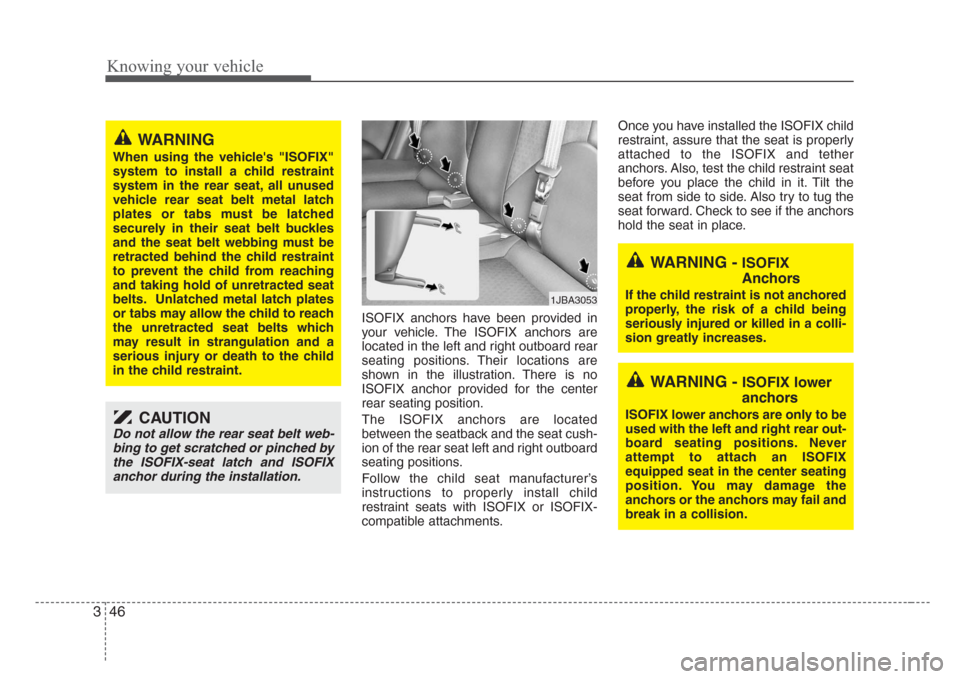
Knowing your vehicle
46 3
ISOFIX anchors have been provided in
your vehicle. The ISOFIX anchors are
located in the left and right outboard rear
seating positions. Their locations are
shown in the illustration. There is no
ISOFIX anchor provided for the center
rear seating position.
The ISOFIX anchors are located
between the seatback and the seat cush-
ion of the rear seat left and right outboard
seating positions.
Follow the child seat manufacturer’s
instructions to properly install child
restraint seats with ISOFIX or ISOFIX-
compatible attachments.Once you have installed the ISOFIX child
restraint, assure that the seat is properly
attached to the ISOFIX and tether
anchors. Also, test the child restraint seat
before you place the child in it. Tilt the
seat from side to side. Also try to tug the
seat forward. Check to see if the anchors
hold the seat in place.
WARNING - ISOFIX
Anchors
If the child restraint is not anchored
properly, the risk of a child being
seriously injured or killed in a colli-
sion greatly increases.
WARNING - ISOFIX lower
anchors
ISOFIX lower anchors are only to be
used with the left and right rear out-
board seating positions. Never
attempt to attach an ISOFIX
equipped seat in the center seating
position. You may damage the
anchors or the anchors may fail and
break in a collision.
WARNING
When using the vehicle's "ISOFIX"
system to install a child restraint
system in the rear seat, all unused
vehicle rear seat belt metal latch
plates or tabs must be latched
securely in their seat belt buckles
and the seat belt webbing must be
retracted behind the child restraint
to prevent the child from reaching
and taking hold of unretracted seat
belts. Unlatched metal latch plates
or tabs may allow the child to reach
the unretracted seat belts which
may result in strangulation and a
serious injury or death to the child
in the child restraint.
1JBA3053
CAUTION
Do not allow the rear seat belt web-
bing to get scratched or pinched by
the ISOFIX-seat latch and ISOFIX
anchor during the installation.
Page 57 of 219
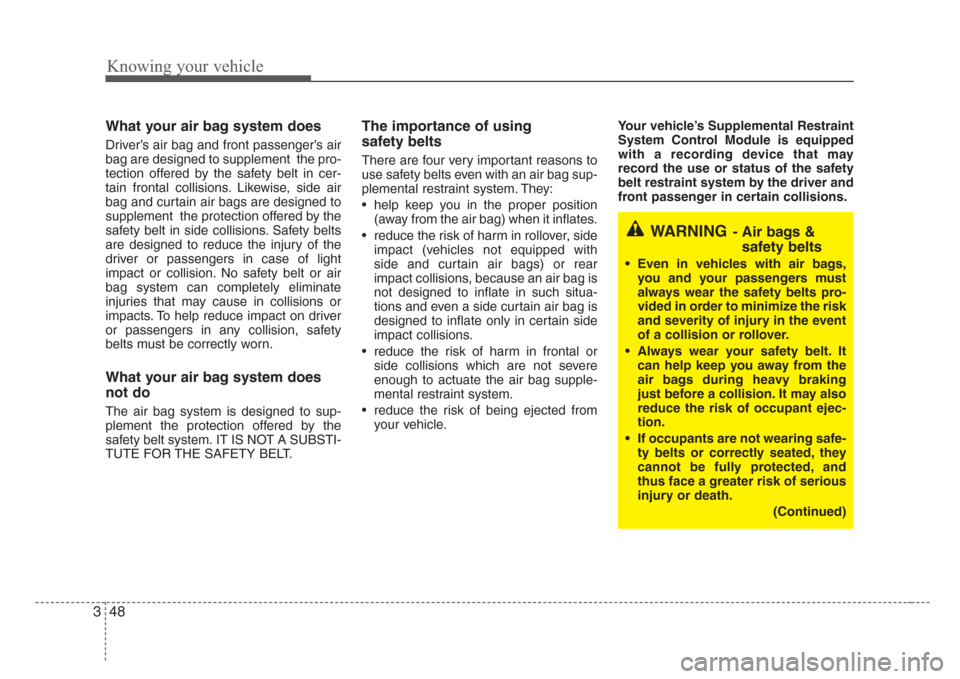
Knowing your vehicle
48 3
What your air bag system does
Driver’s air bag and front passenger’s air
bag are designed to supplement the pro-
tection offered by the safety belt in cer-
tain frontal collisions. Likewise, side air
bag and curtain air bags are designed to
supplement the protection offered by the
safety belt in side collisions. Safety belts
are designed to reduce the injury of the
driver or passengers in case of light
impact or collision. No safety belt or air
bag system can completely eliminate
injuries that may cause in collisions or
impacts. To help reduce impact on driver
or passengers in any collision, safety
belts must be correctly worn.
What your air bag system does
not do
The air bag system is designed to sup-
plement the protection offered by the
safety belt system. IT IS NOT A SUBSTI-
TUTE FOR THE SAFETY BELT.
The importance of using
safety belts
There are four very important reasons to
use safety belts even with an air bag sup-
plemental restraint system. They:
• help keep you in the proper position
(away from the air bag) when it inflates.
• reduce the risk of harm in rollover, side
impact (vehicles not equipped with
side and curtain air bags) or rear
impact collisions, because an air bag is
not designed to inflate in such situa-
tions and even a side curtain air bag is
designed to inflate only in certain side
impact collisions.
• reduce the risk of harm in frontal or
side collisions which are not severe
enough to actuate the air bag supple-
mental restraint system.
• reduce the risk of being ejected from
your vehicle.Your vehicle’s Supplemental Restraint
System Control Module is equipped
with a recording device that may
record the use or status of the safety
belt restraint system by the driver and
front passenger in certain collisions.
WARNING- Air bags &
safety belts
• Even in vehicles with air bags,
you and your passengers must
always wear the safety belts pro-
vided in order to minimize the risk
and severity of injury in the event
of a collision or rollover.
•Always wear your safety belt. It
can help keep you away from the
air bags during heavy braking
just before a collision. It may also
reduce the risk of occupant ejec-
tion.
• If occupants are not wearing safe-
ty belts or correctly seated, they
cannot be fully protected, and
thus face a greater risk of serious
injury or death.
(Continued)